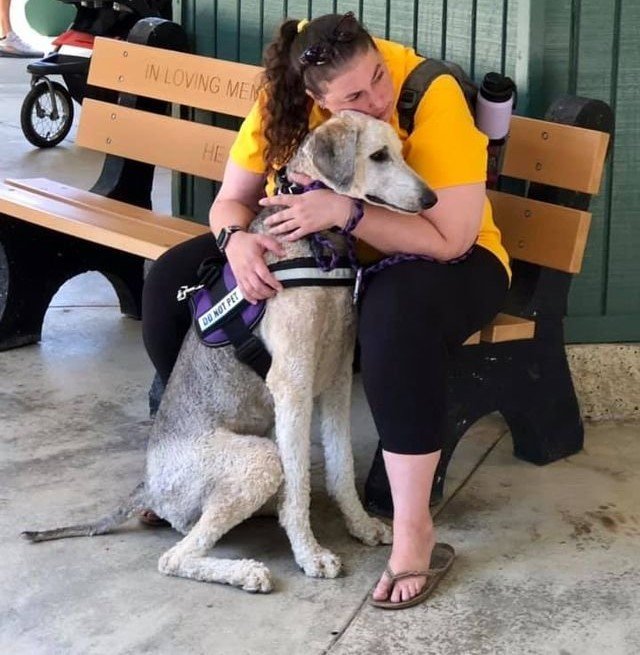How Should a Service Dog Present?
MobilityDog’s 2024 Poodle Palooza
When working in public, a service dog should always exhibit impeccable and focused behavior, distinguishing them from regular pets. Service dogs are specifically trained to assist individuals with disabilities, making their behavior crucial for the handler’s safety and maintaining public access privileges. (Source: ADA.gov)
So, which specific five behaviors should a working service dog present when working? (Source: Library of Congress)
A MobilityDog Service Dog Calmly Sitting
5 Key Behaviors of Service Dogs in Public
Calm Demeanor and Focus: Service dogs must remain calm and attentive to their handler, even in busy or noisy environments. They should also be gentle and stable without fear or aggression. Their training emphasizes ignoring distractions like other animals, people, and food, allowing them to stay focused on their tasks, which may include alerting, guiding, or providing mobility assistance.
Non-Disruptive Presence: A hallmark of a well-trained service dog is its ability to remain unobtrusive. These dogs stay by their handler's side or lay quietly when the handler is seated, without barking, jumping, or sniffing around excessively. Barking is generally only acceptable if it’s part of the dog’s trained response, such as alerting a handler to a medical issue.
Leash and Command Control: Proper leash behavior is crucial, and service dogs are trained to walk without pulling, lunging, or circling their handler. They respond promptly to commands, which is essential for their role as assistants to individuals with disabilities.
Housebroken and Clean: Public behavior expectations also extend to cleanliness. Service dogs must be housebroken and avoid relieving themselves in inappropriate areas. Furthermore, they should be well-groomed to ensure a professional appearance as working canines.
Appropriate Public Interactions: A service dog should not interact with strangers or animals. This discipline is especially critical to preventing disruptions in restaurants, stores, or public transportation, where distractions are abundant and the handler’s safety is paramount.
Our Trained MobilityDog Service Dogs Out in Public
Unfortunately, the public still has many misconceptions about service dogs. Below, we’ll look at the most common ones and their negative ramifications for the service dog team and maintaining public access protected by the ADA Act.
Addressing Service Dog Misconceptions
Service dogs should not display uncontrolled or aggressive behaviors. These undesirable behaviors can create misunderstandings about their role and even lead to access denial.
Some individuals may attempt to bring untrained pets into public spaces by falsely claiming they are service animals, which skews public perception and creates difficulties for legitimate service dog teams.
The use and misbehavior of these "fake service dogs" have created confusion and hesitancy among businesses, threatening full accessibility for those who need it most. Therefore, all handlers must ensure their dogs meet public standards.
Conclusion
In short, service dogs should be calm, well-behaved, and responsive to their handler’s commands in public. (Source: MobilityDog.org) This behavior is:
A sign of their extensive training; and
A requirement under the ADA Act and related laws, which help maintain the essential balance between:
Access rights for service dog handlers and
The safety and comfort of the general public.
A Woman Hugging Her Calm Service Dog
For more information on service dog behavior, consult MobilityDog and FACTS ABOUT SERVICE DOGS and Applying for a Service Dog which detail training standards and public access guidelines.
All images courtesy of MobilityDog.org.
Donate Here to Help Us Continue to Serve Our Community!





